Abstract
In the current context of joint efforts towards the decarbonisation of buildings, integrating occupants’ comfort and health with latest technological advancements for energy efficiency is at the center of the latest development of research, policies and professional practice. Radiant systems are encountering great success since the low-thickness systems can also be used in renovation projects for both heating and cooling, while guaranteeing optimal comfort. However, dehumidification is often required for optimal radiant cooling operation with no condensation risks, and the great potential of mechanical ventilation systems to optimally address the needs for dehumidification, air renewal, health and energy efficiency appears to be far from its full exploitation in the post-COVID-19 era. The present paper aims at providing a quantification of the energy and financial impacts of the implementation of a controlled mechanical ventilation system (CMV) coupled to a radiant system in a typical residential case study building in Italy. The results show that the sole CMV may decrease primary energy demand and energy costs by more than 30% and contribute to an increase in the smart readiness of the building by 8%, but further incentive policies must be developed to cover the still high investment and maintenance cost.
1. Introduction
In the current context of improved efforts for the decarbonisation of the building sector, radiant systems are encountering great success, as their operating conditions allow optimal integration with high-efficiency generation systems and renewable energy sources both in the heating and cooling mode. Recent technological advancements in the sector have contributed to overcoming the traditional barriers to the massive applicability of such systems, since the currently available low-thickness/low-inertia radiant systems can be easily used in all types of intervention, including renovation projects. Considering the projected increasing cooling needs, the use of radiant systems has been demonstrated to be able to effectively meet the buildings’ space cooling demand, but attention should be paid to the condensation risks that may occur. This issue should be primarily addressed through the setup of an advanced control system for proper adjustments of the radiant cooling system operation in relation to the ambient hygrothermal conditions. However, the installation of a dehumidification system is often required to avoid any risk and ensure the optimal comfort of the occupants.
In the last years, integrating indoor comfort and health to the highest energy efficiency has been at the center of the latest developments in research and in the development of directives and regulation towards the objectives of the full decarbonisation of the building sector [1]. Moreover, the COVID-19 pandemic context has reinforced the need for adequate indoor air quality, highlighting the need for the optimal integration of strategies addressing the two pillars of energy efficiency and health in all types of buildings.
In the European Union, the latest recast of the Energy Performance of Buildings Directive (2018/844/EU [2]) has remarked that the energy needs for space heating, space cooling, domestic hot water, ventilation, lighting and other technical building systems shall be calculated in order to optimise the health, indoor air quality and comfort levels defined by Member States at national or regional levels. The recent proposal for a new recast of EPBD [3] further highlights the role of the adequate design and maintenance of ventilation systems in ensuring occupant comfort and health.
At international levels, the WELL building standard [4] is driving professional practice to focus on occupants’ health and well-being and put efforts into the implementation of the most advanced research evidences in the field, contributing to an increasing holistic vision for a multi-domain evaluation of the benefits reached by energy efficiency measures. This multi-domain perspective was embraced by the EU during the development of the building Smart Readiness Indicator (SRI), where buildings’ energy efficiency and flexibility, comfort and health are weighted according to different impact criteria and included in the evaluation of the potential contribution to the overall building smartness offered by different HVAC systems technology solutions.
In this context, the great potential of mechanical ventilation systems to find synergies between different domains and address the need for air renewal, dehumidification and smart energy efficiency at the same time appears to be far from its full exploitation, especially in the residential sector. A recent review on the integrated radiant heating/cooling with ventilation system [5] recognised that many design parameters need to be considered when designing such a system, such as location, the amount of heat sources, contaminant source types and condensation risk. While it provides guidelines for their optimisation considering the impacts on thermal comfort and indoor air quality, their mutual impact on energy performance is recognised but not studied, leaving space for further studies. Further, the economic issues are not considered. Another review [6] on the application of radiant low-temperature heating and high-temperature cooling compares latest studies addressing the domains of energy, thermal comfort, indoor air quality, design and control, and suggests further investigations on the economic incentives for radiant systems based on the country studied for different markets. Further, it recommends extending the application of radiant systems in residential buildings in addition to commercial buildings.
In fact, especially after the implementation of energy efficiency measures on the building envelope (thermal insulation and increase in air tightness above all), the issues related to low indoor air quality (IAQ) that were typically addressed for densely occupied non-residential buildings have been extended to residential buildings [7]. Figure 1 reports an example of IAQ monitoring in a single-family house equipped with a radiant panel, showing a typical trend of a significant increase in CO2 levels, especially at night in bedrooms when CMV is not present. A recent study [8] demonstrated that the impact of a low IAQ may also be significant in residential buildings, as the one-year long comparative study has shown that an increased level of indoor air quality parameters, and particularly CO2 above 1000 ppm, which is closely related to the indoor ventilation rate, was associated with the daily risk of eye fatigue, allergic rhinitis and atopic dermatitis symptoms.

Figure 1.
Two-day example of indoor monitoring of a typical residential unit in Italy.
In this context, the great potential of mechanical ventilation systems to optimally address the need for air renewal and health, dehumidification (especially when radiant systems are used for space cooling) and energy efficiency at the same time appears to be far from its full exploitation, preventing mechanical ventilation systems from following the increasing positive trend in the implementation of radiant systems, especially in the residential sector. This appears to be mainly due to a wrong perception of related costs and benefits from both the private investor and policymakers’ perspectives.
Objectives and Approach
The objective of the present work is to provide methods and results for qualitative and quantitative integrated analysis on the multi-domain impacts of the implementation of a controlled mechanical ventilation system (CMV) coupled to a radiant system in a residential case study building in Italy.
With the support of the decision-making tools and performance indicators established by the EU for decision-making in the fields, the quantification of the different impacts is performed in terms of:
- Energy efficiency: evaluation of the annual primary energy performance and related energy cost before and after CMV installation;
- Financial feasibility: determination of the relevant financial parameters, calculation of the global cost over a time period from an investor’s perspective and sensitivity to the variation of financial parameters, energy prices and inventive policies;
- Multi-domain benefits: perspectives for the quantification of the impact of CMV on the comfort and health aspects of a smart building.
2. Materials and Methods
2.1. Description of the Case Study Building
The building used as a reference for the development of the analyses is an all-electric NZEB named CORTAU House (see Figure 2), built in 2016 based on the retrofit of a traditional rural building. The building is located in the Piedmont region, in the north-west of Italy (climate zone E), and has a 140 m2 floor area. Because it has already been analysed in detail in the literature regarding its design [9], based on a cost-optimal approach according to the latest EU directives [10], and its performance in operation [11], it is recognised as a representative case study of NZEB buildings in Italy.
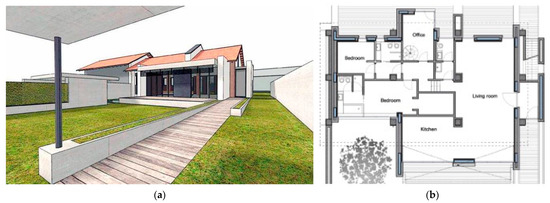
Figure 2.
The case study building: (a) 3D visualisation; (b) main plan of the ground floor.
The externally insulated opaque envelope meets the local requirements for deep energy retrofit, resulting in a highly insulated building (Uwall = 0.14 W/(m2K), Uroof = 0.11 W/(m2K), Uslab = 0.12 W/(m2K); Uwin = 1.2 W/(m2K)).
The building is all-electric, with a system composed of an air-to-water geothermal heat pump and radiant floors for space heating and cooling. The same heat pump is also used for domestic hot water production through a heat exchanger in a dedicated water storage.
2.1.1. Definition of Scenarios for the HVAC System
According to the scope of the present work, two alternative scenarios were identified for the building system (Table 1). Both scenarios include a reversible heat pump and low-thickness radiant floor intended for use in both the heating and cooling modes. In the NV scenario, there is no control of fresh air exchange, which is assumed to be provided through natural ventilation (window opening). In the CMV scenario, a mechanical ventilation system with enthalpic heat recovery is added for the purpose of air dehumidification and increased energy efficiency, therefore reducing the radiant system sizing.

Table 1.
Name and description of the two defined scenarios for HVAC system.
2.1.2. Inputs for Energy Calculation
For the purpose of the determination of energy needs through dynamic simulation (EnergyPlus), the latest typical reference year available for the nearest weather station (Torino 160590—IWEC) was used for carrying out simulations. The operational parameters were defined to be consistent with the building typology. The occupancy was fixed to 0.04 person/m2, according to Italian Standard UNI 10339 [12]. Lighting and electric equipment maximum power densities were, respectively, set equal to 4.5 W/m2 and 2.98 W/m2, according to European Standard ISO 13790 [13], and their daily and weekly profiles refer to those reported in ASHRAE 90.1 standards for reference residential buildings. In addition, the control of the solar shading was scheduled based on the total solar radiation incident on each window (threshold 300 W/m2).
The heating system was assumed to be active from 15 October to 15 April, according to Italian regulations for Climatic Zone E (Turin), with a set point that was fixed to 20 °C from 7 a.m. to 8 p.m. and to 18 °C during the rest of the day. The cooling system was set to operate from 30 April to 30 September with a set point that was set to 26 °C from 7 a.m. to 5 p.m. and to 28 °C in the other hours.
According to the Italian standard for energy calculation [14], the ventilation rate was set to 0.5 ach. Considering that the net building conditioned volume is 378 m3, the required fresh air flow rate is 190 m3/h.
For the purpose of the calculation of electrical energy consumptions, the reference efficiencies were considered according to the Italian law [15] for the heat pump (COP 3, EER 2.5) and radiant system (the considered value of 0.81 includes losses due to distribution, regulation and emission). Such seasonal efficiencies are in line with real data obtained from the monitoring of similar systems in residential contexts [16]. For the calculation of primary energy, the Italian primary energy conversion factors for electricity are used (2.42 is the total primary energy conversion factor, 1.95 and 0.47 are the non-renewable and renewable parts, respectively).
2.1.3. Inputs for Cost Calculation
The process for the determination of the costs of the materials related to the NV and CMV scenarios is reported in Figure 3. Starting from real detailed quotes provided by manufacturing companies operating in the region, several simulated quotes were created based on available price lists from other manufacturers. All data are referred to the market prices applied in the first semester of the year 2022. Detailed quotations include the supply and installation of all the components of systems that are subject to variation in the different scenarios, which are radiant systems and the mechanical ventilation system. For radiant systems, the costs regarding pipes and hydraulic connections (collectors, valves) and other package components (insulation panels, cement screed, regulation) were considered. For the ventilation system, the costs regarding central units (ventilation units with enthalpic heat recovery and dehumidification, regulation system) and distribution components (plenums, ducts, vents) were considered.
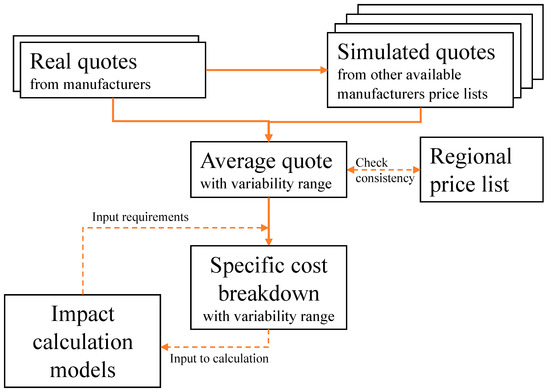
Figure 3.
Process for determination of cost-related inputs to be used in the impact calculation models.
Data were then elaborated to obtain an average quote for each of the two main systems (radiant and ventilation) associated to a variability range, also considering their consistency with the regional price list. Starting from a detailed average quote, a specific cost breakdown could be obtained according to the inputs required by the implemented impact calculation models, as reported in the next section.
A summary of the resulting cost breakdown, for the systems involved in the two scenarios of the present paper, is reported in Table 2, specific for relevant units. The annual maintenance costs are expressed as a percentage of investment as for EN 15459.

Table 2.
Specific cost breakdown.
Regarding the energy costs, the average electricity price (including taxes) for Italian households for the year 2022 was considered (0.3 €/kWh), according to the latest statistics and projections made by the EU statistical institute (Eurostat [17]).
2.2. Impact Calculation Models
2.2.1. The Cost-Optimal Approach and the Global Cost Calculation Model
The concept of cost-optimality was introduced by the European Directive 2010/31/EU [18], also known as the recast of Energy Performance of Buildings Directive—EPBD recast. Such methodology allows the comparison of alternative energy design scenarios so that the decision-maker, who can be either represented by the private investor or the policymaker, can increase his consciousness of their impact on the building energy and financial-economic performance. The combined calculation for each of the evaluated scenarios of the energy indicator, expressed in terms of primary energy, and of the global cost indicator, determined as the sum of the investment (also including maintenance, replacement and disposal costs) and operational energy cost, allows identifying the scenario leading to the lowest cost during the estimated economic life cycle of the building, which therefore defines the cost-optimal level for decision-making.
The so-called cost-optimal graph is reported in Figure 4, where the global cost values of the different scenarios (each orange point is an alternative energy design scenario) are on the y-axis (y) and the annual primary energy consumption is on the x-axis.
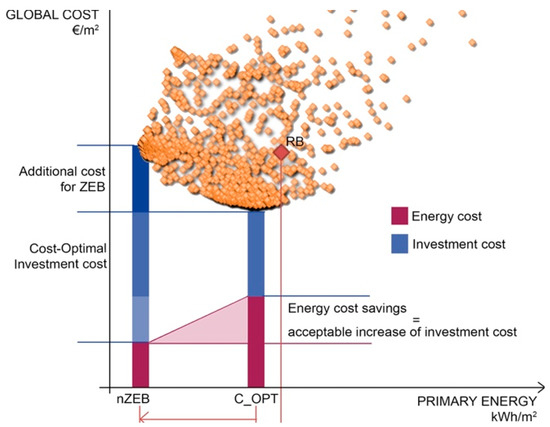
Figure 4.
Graph for determination of cost-optimal levels. nZEB indicates the nearly Zero Energy Buildings’ performance level, C_OPT indicates the energy performance level related to the lowest global cost over the considered calculation period (economic life cycle of the building), where each orange point represents a different design alternative.
Typically, when comparing multiple scenarios, the ones leading to the best performances (towards zero-energy objectives) are related to higher investment costs, which may lead to an overall increase in the global cost if the savings on energy costs are not enough to compensate for such increase. Therefore, as shown in Figure 4, the cost-optimal approach also involves identifying the extra investment cost that is acceptable to ensure the cost-optimality of the more energy-efficient scenarios.
The most recent model for the calculation of the global cost was developed in EN15459:2018 [19], where the global cost CG is formulated for the calculation period TC, and referred to the starting year T0 as follows:
where CG, CINIT are the initial investment costs; COa(i)(j) is the annual cost for year i for component or service j (including maintenance and energy costs); RATXX(i)(j) is the price development for year i for component or service j; COCO2(i)(j) is the CO2 emissions cost for measure j during year i; COfin(TLS)(j) is the final (disposal) cost for decommissioning, deconstruction and disposal in the last year of life cycle TLS of component j or of building (referred to starting year T0); Vft(TC)(j) is the residual value of component j in year TC at the end of the calculation period (referred to starting year T0); and D_f(i) is the discount factor for year i based on the real interest rate RR.
CG = CINIT + Σj [Σi=1 TC (COa(i)(j) × (1 + RATXX(i)(j)) + COCO2(i)(j)) × (D_f (i)) + COfin(TLS)(j) − Vft(TC)(j)]
As shown in Equation (1), the global cost considers the initial investment cost to implement energy efficiency interventions, to which the operational costs, also known as annual costs (the energy costs, ordinary and extraordinary costs related to maintenance and replacement costs), are added during the overall life of the investment; that is, until the intervention itself may have a residual value.
For the present application, a financial calculation from the perspective of a private investor is considered, therefore excluding COCO2(i)(j), which should only be considered at a macroeconomic level, but including taxes and current incentive policies (50% of investment is discounted as tax deductions in 10 years). Initial investment costs were set according to Table 2, tailored to each scenario (the investment costs of the radiant systems consider the different sizing in each scenario, and the costs for the mechanical ventilation systems are not considered in the NV scenario). Moreover, the disposal costs for radiant systems were not considered as the estimated TLS (50 years).
A summary of the values assigned to the different calculation parameters considered for the present study is reported in Table 3.

Table 3.
Parameter values for global cost calculation.
2.2.2. The Multi-Domain Approach and the SRI Evaluation Model
As mentioned, the 2018 revision of the European Energy Performance of Buildings Directive heavily emphasised the potential of smart technologies in the building sector to decarbonise the building sector, while offering healthier, more efficient and comfortable living environments. Therefore, the concept of a “Smart Readiness Indicator” (SRI) was introduced as a framework for rating the smart readiness of buildings, and its calculation model was launched in 2022 [23].
The SRI assesses buildings (or building units) based on their capacity to satisfy three key functionalities: (1) optimise energy efficiency and overall in-use performance; (2) adopt the building operation to the needs of the occupants; and (3) adopt the signals from the grid (energy flexibility). For each functionality, different impact criteria were identified, as shown in Figure 5. For grouping the different smart ready services that the building has or could use (“service catalogue”), nine technical domains are identified, and ventilation is one of them (Figure 6).
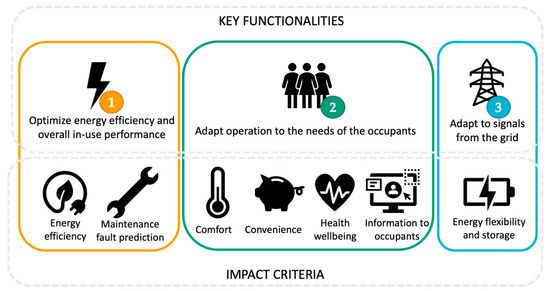
Figure 5.
Functionalities impact criteria for SRI evaluation [23].
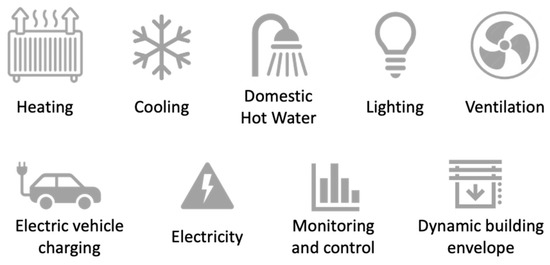
Figure 6.
Technical domains for building services [23].
The different functionality levels are then identified for the different smart ready services in each technical domain (from 0-baseline to a maximum of 4), and a score is assigned to each functionality level in relation to each impact criterion.
The proposed score matrix for services related to the ventilation technical domain is shown in Figure 7. According to the simplified smart services catalogue provided by the EU [24], the NV scenario corresponds to Level 0, while the CMV scenario refers to level 3.
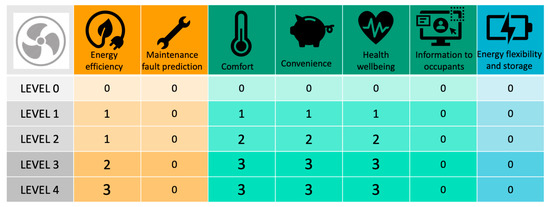
Figure 7.
Scores for functionality levels of ventilation systems for impact criteria data from [24].
As described in [25], smart readiness scores SRd,ic of a single technical domain d along each impact criterion ic can be calculated (expressed as a percentage) as follows:
where I(d,ic) is the impact criterion score of domain number d for impact criterion number ic according to the functionality level of each scenario, and Imax(d,ic) is the maximum impact criterion score of domain number d for impact criterion number ic referring to the highest functionality level.
SRd,ic = I(d,ic)/Imax(d,ic) × 100
When aggregating multiple domains (up to N) for each of the impact criteria, the smart readiness scores of each technical domain can be determined by weighing the calculated scores as follows:
where wd,ic is the weighting factor expressed as a percentage of the technical domain number d for the impact criterion number ic. The approach proposed by the EU allocates weighting factors based on climate zones, building typology and overall building energy balance for heating, cooling, DHW, ventilation and lighting and electricity technical domains, while otherwise fixing equal weighting factors by up to 100% for each impact criterion.
SRic = ΣN(wd,ic × I(d,ic))/ΣN(wd,ic × Imax(d,ic)) × 100
The smart readiness scores along the three key capabilities c can be determined by further weighting the calculated scores as follows:
where SRc is the smart readiness score for key capability c, M is the total number of impact criteria, Wd,ic is the weighting factor expressed in the percentage of the impact criterion number ic for key functionality f and SRic is described in Equation (3). Among the same key functionality, equal weight is assigned to all the relevant impact criteria. The total smart readiness score SRI for a building can be then determined by equally weighting the calculated smart readiness scores SRc for the key capability as follows:
SRc = ΣM(Wd,ic × SRic)
SR = Σ 1/3 × SRc
As shown in Figure 7, the ventilation domain may affect the score of impact criterion “energy efficiency” in the key capability (1) and the impact criteria “comfort”, “convenience” and “health” on the key capability (2). In the present study, calculations have been performed to estimate the potential contribution of scenario CMV to increasing the smart readiness score at different levels (Equations (2)–(5)) with respect to scenario NV, therefore only considering variations in the technical domain of “controlled ventilation”.
3. Results
After presenting the energy calculations resulting from the implementation of the two scenarios, the impacts of the implementation of the CMV scenario with respect to the NV scenario are quantified according to the described models for impact calculation.
3.1. Energy Evaluation
The resulting overall electricity consumption and the primary energy demand are reported in Figure 8. As shown, the overall energy demand in the CMV scenario is 30% lower than the NV scenario (because of the all-electric energy consumptions, the resulting percentage reduction is equal in both graphs). Regarding the breakdown of electricity consumptions, the orange part related to the ventilation system in the CMV scenario is related to the consumption of mechanical ventilation fans. The energy needed for covering thermal loads due to the introduction of fresh air is included in the electricity consumption allocated to the radiant systems. Regarding the breakdown representation of the primary energy demand, the orange bar includes both the thermal and electrical consumptions related to ventilation.

Figure 8.
For the two NV and MV scenarios, quantification of (a) electricity consumption; (b) primary energy demand.
3.2. Cost Evaluation
The results related to the calculation of the global cost for the two scenarios are presented in Figure 9, where the top graph shows the calculated global cost (specific to the conditioned floor area of the case study), with their variability resulting from the uncertainty regarding the estimation of costs. It is shown that the calculated global cost for the CMV scenario is on average 86% higher than the NV scenario (with a potential variability between +74% and +97%). The bottom graph of Figure 9 reports the breakdown of the calculated average global cost, showing that the CMV scenario determines a high increase in the investment cost (despite a slight decrease in the investment for the radiant system due to reduced sizing).
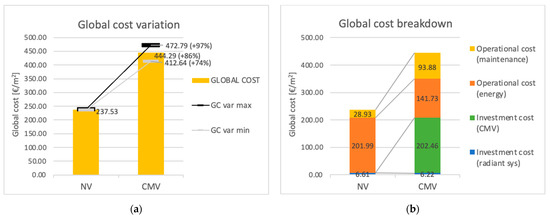
Figure 9.
For the two NV and MV scenarios, quantification of (a) specific average global cost with variation range; (b) breakdown of resulting average global cost values.
The graphs in Figure 10 report the analysed scenarios on the cost-optimal graph, showing the sensitivity of the global cost to the variation of the interest rate (from 2.5%, the current base rate, to 4.5%, as suggested by the EU guidelines), energy price (up to 0.7 €/kWh, reflecting the peak price of the latest months) and incentives (up to 110% on investment costs as tax deduction, reflecting the incentive policies implemented in the latest 3 years).
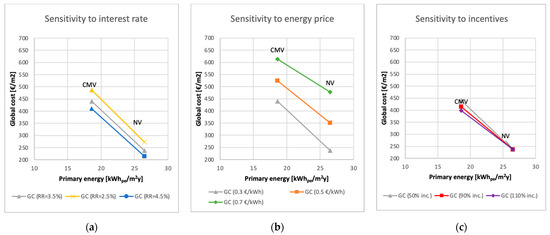
Figure 10.
Sensitivity analysis for the value of global cost in relation to the variation of (a) real interest rate; (b) energy price; (c) incentives (reduction of investment cost by means of tax detraction).
3.3. SRI Evaluation
The results related to the potential increase in SRI at different levels due to the implementation of the CMV scenario are reported in Table 4. CMV may increase the SR for energy efficiency by almost 15% and for health by 20%. Overall, the implementation of mechanical ventilation may increase the SRI of the whole building by 7.2%.

Table 4.
Potential increase in SRI in CMV scenario.
4. Discussion
The results show that the implementation of a mechanical ventilation system may have a significant impact on energy efficiency (30% reduction of primary energy needs, which is consistent with the findings of previous studies [6]), but the global cost calculations demonstrate that, in the current market and policy scenario, the reduction of energy costs in CMV is not enough to compensate for the higher investment and maintenance costs occurring in the CMV scenario.
The performed sensitivity analysis shows that the trend is substantially the same even when there is variation in the financial scenario (interest rate) or an increase in the incentive investments. The increase in energy prices may lead to the relative increase in the global cost of CMV with respect to NV to be reduced, but the global cost of the CMV scenario is still 28% higher than NV, with the electrical energy cost being 0.7 €/kWh. In view of these results, and in the context of the post-COVID-19 era, more efforts in research and technological advancements may help to decrease the costs of such systems. In addition, different incentive policies could be designed and tailored according to the sector of the ventilation systems, considering their multi-domain impacts on energy efficiency, comfort and health.
In fact, when considering the SRI approach for a multi-domain impact estimation of the implementation of the CMV scenario, results are more promising, as envisioned in [25]. Beyond the demonstration of the potential significant contribution of a mechanical ventilation system to increase the overall SRI of a residential building, the multi-domain approach and the weighting system for the different impact sectors at the basis of the model can be further applied to properly weight and integrate energy efficiency aspects and occupants’ health and well-being in indoor environment from a holistic, human-centered perspective that should also drive economic factors.
Moreover, further research efforts may lead to the evolution of the global cost approach towards the form of the so-called Cost-Benefit Analysis (CBA) [26], which allows combining the financial approach with a larger economic perspective that introduces additional externalities in the assessments, such as the increase in the market value of an asset as a result of energy efficiency interventions, the positive effects on occupant health induced by the use of efficient technologies for improving air quality, or the high levels of indoor comfort achievable in the building itself. A cost-benefit analysis tailored to ventilation systems is expected to be able to improve the formulation itself and the resulting positive impacts by introducing the quantification of not only economic benefits, but also social benefits or benefits related to the occupants’ comfort and well-being in the indoor environments.
5. Conclusions
The impact of the installation of a controlled mechanical ventilation and dehumidification system for use with a radiant heating and cooling system has been studied in terms of energy efficiency, global cost and whole building multi-domain smart readiness.
The results show that the sole CMV may decrease primary energy demand and energy costs by more than 30% and contribute to increasing the smart readiness of the building by 7.2%, but further advancements in technologies and policies must be developed to cover the still high investment and maintenance cost.
Future work should deepen the analysis on a real building by monitoring the actual energy and cost performance before and after the installation of the studied CMV system.
Moreover, based on the multi-domain approach offered by the SRI model, a quantification of the benefits in the area of health and well-being may help to develop better assessment tools to consider energy efficiency interventions from a human-centered perspective.
Author Contributions
Conceptualisation, M.F. and E.F.; methodology, M.F.; software, M.F.; validation, C.P. and M.F; formal analysis, M.F.; investigation, M.F.; resources, S.P.C.; data curation, C.P. and M.F.; writing—original draft preparation, M.F.; writing—review and editing, C.P.; visualisation, M.F.; supervision, S.P.C. All authors have read and agreed to the published version of the manuscript.
Funding
This research was developed within the joint agreement between Q-rad and Politecnico di Torino. Maria Ferrara’s activity was funded by Italian MUR within the PON “Ricerca e Innovazione” 2014–2020, Asse IV “Istruzione e ricerca per il recupero”—Azione IV.4—“Dottorati e contratti di ricerca su tematiche dell’innovazione” e Azione IV.6—“Contratti di ricerca su tematiche Green”.
Data Availability Statement
The data presented in this study are available on request from the corresponding author. The data are not publicly available due to privacy issues.
Conflicts of Interest
The authors declare no conflict of interest.
References
- Ferrara, M.; Prunotto, F.; Rolfo, A.; Fabrizio, E. Energy Demand and Supply Simultaneous Optimization to Design a Nearly Zero-Energy House. Appl. Sci. 2019, 9, 2261. [Google Scholar] [CrossRef]
- Directive (EU) 2018/844 of the European Parliament and of the Council of 30 May 2018 Amending Directive 2010/31/EU on the Energy Performance of Buildings and Directive 2012/27/EU on Energy Efficiency; Publications Office of the European Union: Luxembourg, 2018.
- Proposal for a Directive of the European Parliament and of the Council on the Energy Performance of Buildings (Recast)—COM/2021/802 Final; Publications Office of the European Union: Luxembourg, 2021.
- WELL Building Standard. Available online: https://v2.wellcertified.com/en/wellv2/overview (accessed on 10 December 2022).
- Zhang, C.; Pomianowski, M.; Heiselberg, P.V.; Yu, T. A review of integrated radiant heating/cooling with ventilation systems- Thermal comfort and indoor air quality. Energy Build. 2020, 223, 110094. [Google Scholar] [CrossRef]
- Hesaraki, A.; Huda, N. A comparative review on the application of radiant low-temperature heating and high-temperature cooling for energy, thermal comfort, indoor air quality, design and control. Sustain. Energy Technol. Assess. 2022, 49, 101661. [Google Scholar] [CrossRef]
- Carrer, P.; Wargocki, P.; Fanetti, A.; Bischof, W.; De Oliveira Fernandes, E.; Hartmann, T.; Kephalopoulos, S.; Palkonen, S.; Seppänen, O. What does the scientific literature tell us about the ventilation–health relationship in public and residential buildings? Build Environ. 2015, 94, 273–286. [Google Scholar] [CrossRef]
- Lim, A.-Y.; Yoon, M.; Kim, E.-H.; Kim, H.-A.; Lee, M.J.; Cheong, H.-K. Effects of mechanical ventilation on indoor air quality and occupant health status in energy-efficient homes: A longitudinal field study. Sci. Total Environ. 2021, 785, 147324. [Google Scholar] [CrossRef] [PubMed]
- Barthelmes, V.M.; Becchio, C.; Corgnati, S.P.; Guala, C. Design and construction of an nZEB in Piedmont Region, North Italy. Energy Procedia 2015, 78, 1925–1930. [Google Scholar] [CrossRef]
- Barthelmes, V.M.; Becchio, C.; Bottero, M.C.; Corgnati, S.P. The Influence of Energy Targets and Economic Concerns in Design Strategies for a Residential Nearly-Zero Energy Building. Buildings 2014, 4, 937–962. [Google Scholar] [CrossRef]
- Abbà, I.; Crespi, G.; Lingua, C.; Becchio, C.; Corgnati, S.P. Theoretical and actual energy behaviour of a cost-optimal based NZEB. REHVA J. 2021, 1, 22–27. [Google Scholar]
- UNI 10339:1995; Impianti Aeraulici ai Fini del Benessere. In Generalità,Classificazione e Requisiti. Regole per la Richiesta D’offerta, L’offerta, L’ordine e la Fornitura. Ente Italiano di Normazione (UNI): Milano, Italia, 1995. (In Italian)
- EN ISO 13790:2008; In Energy Performance of Buildings Calculation of Energy Use for Space Heating and Cooling. European Committee for Standardization (CEN): Brussels, Belgium, 2008.
- UNI/TS 11300-1:2014; Standard for Calculation of Energy Performance of Buildings—Part 1. Ente Italiano di Normazione (UNI): Milano, Italia, 2014. (In Italian)
- DM 26/06/2015; Ministerial Decree on the Application of Calculation Methodologies for Energy Performance and Definition of Prescriptions and Minimum Requirements of Buildings. International Energy Agency: Paris, France, 2015. (In Italian)
- Biglia, A.; Ferrara, M.; Fabrizio, E. On the real performance of groundwater heat pumps: Experimental evidence from a residential district. Appl. Therm. Eng. 2021, 192, 116887. [Google Scholar] [CrossRef]
- Available online: https://ec.europa.eu/eurostat/statistics-explained/index.php?title=Electricity_price_statistics#Electricity_prices_for_household_consumers (accessed on 18 November 2022).
- European Union. Directive 2010/31/EU of the European Parliament and of the Council of 19 May 2010 on the Energy Performance of Buildings (Recast). Off. J. Eur. Union 2010, L153/13, 13–35. [Google Scholar]
- EN 15459:2018; Energy Performance of Buildings—Economic Evaluation Procedure for Energy Systems in Buildings—Part 1: Calculation of Module M1-14. European Standard: Brussels, Belgium, 2017.
- Guidelines Accompanying Commission Delegated Regulation (EU) No 244/2012 of 16 January 2012 Supplementing Directive 2010/31/EU; Publications Office of the European Union: Luxembourg, 2012.
- EU Reference Rate. Available online: https://competition-policy.ec.europa.eu/state-aid/legislation/reference-discount-rates-and-recovery-interest-rates/reference-and-discount-rates_e (accessed on 10 December 2022).
- Deloitte & Touche. Communication from the Commission on the Revision of the Method for Setting the Reference and Discount Rates. Off. J. Eur. Union 2008, C 14/6, 6–9. [Google Scholar]
- European Commission. Smart Readiness Indicator (SRI), Training Slide Deck, January 2022 Version. Available online: https://energy.ec.europa.eu/system/files/2022-06/SRI%20training%20slide%20deck%20-%20Version%202%20-%20Jan%202022%20-%20updated.pdf (accessed on 18 November 2022).
- European Commission. Smart Readiness Indicator (SRI): Focus on Ventilation System, June 2022. Available online: https://energy.ec.europa.eu/system/files/2022-06/SRI-Explained-Ventilation-EN.pdf (accessed on 19 November 2022).
- European Commission; Directorate-General for Energy; Verbeke, S.; Aerts, D.; Reynders, G.; Ma, Y.; Waide, P. Final Report on the Technical Support to the Development of a Smart Readiness Indicator for Buildings: Final Report; Publications Office of the European Union: Luxembourg, 2020. [Google Scholar] [CrossRef]
- Directorate-General for Regional Policy. Guide to Cost-Benefit Analysis of Investment Projects: Structural Funds, Cohesion Fund and Instrument for Pre-Accession; Directorate-General for Regional Policy: Brussels, Belgium, 2014. [Google Scholar]
Disclaimer/Publisher’s Note: The statements, opinions and data contained in all publications are solely those of the individual author(s) and contributor(s) and not of MDPI and/or the editor(s). MDPI and/or the editor(s) disclaim responsibility for any injury to people or property resulting from any ideas, methods, instructions or products referred to in the content. |
© 2023 by the authors. Licensee MDPI, Basel, Switzerland. This article is an open access article distributed under the terms and conditions of the Creative Commons Attribution (CC BY) license (https://creativecommons.org/licenses/by/4.0/).